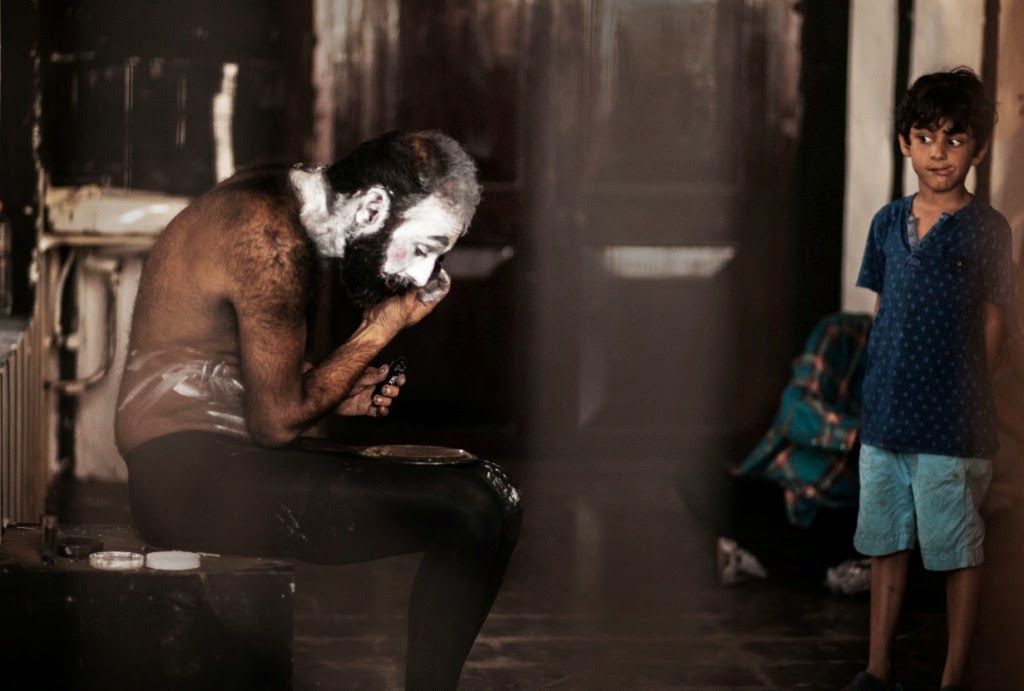Kochi, Mar 15: The curious crowd peered
through the arched window of a ‘cell’ at a Biennale site as he locked himself
inside, stripped down to his undergarment, smeared his face with black paint,
drew drawings on the wall, ate and slept.
For 52 uninterrupted hours, artist Nikhil Chopra spent in the
prison-like cell at Aspinwall House, the major site of the Kochi-Muziris
Biennale (KMB), making ‘performance’ the mainstay of his installation. The
marathon performance ended with the
protagonist’s escape from his cell, leaving wall drawings and theatrical props
as traces of existence. For its sheer length, it was a novel experience
for the exhibition visitors in Kerala.
Mithu Sen spent nearly a month at a Kochi orphanage and adopted a
fictitious name of ‘Mago’ to experience the travails of sexually exploited
minor girls — another example of performance-driven artwork at Aspinwall House.
The performance was documented on a home video camera and an iPhone by the
artist herself and the children, who intermittently took the camera from her.
Gigi Scaria's 'Chronicles of the Shore Foretold' has also a performance
aspect to it. He installed a giant-size metal bell at the Pepper House site by
the Mapilla Khalasis, known for their dock-work techniques. The artist called the very act of installing the 2.5-tonne,
13 feet tall bell a performance, conveying
a message of their labour through his work.
“My favourite audiences are those who are unaware of gallery art and
come to it with curiosity and no preconceived notions,” said Chopra, an alumnus
of Vadodara’s M S University who had earlier
featured in the Venice Biennial 2009. “I want to be able to talk to
women, children…and touch everyone. I want it to be a democratic experience.”
Scaria agrees. “My work has used performance to suggest the importance
of labour; it put into perspective the historic and maritime aspects of the
exhibition,” he says.
“Performance art is very different from theatrical performance in the
manner in which it is conceived and perceived. The performance element is not
too dramatic and it does not have a script; it is a gesture to a situation and
the artist and the viewer get charged from performing and witnessing it,” he
notes.
Elaborating, he says Nikhil Chopra's drawing on the wall is not
something that can be framed or exhibited in another art space. So, the act of
making his work changes the way of looking at art.
At the ongoing KMB, performances come in both overtly
and subtly. For instance, Singaporean Ho Rui An's video installation, ‘Sun, Sweat, Solar Queens: An Expedition’, is all about his performance. It documents his ‘performative
lecture’ done in front of the Aspinwall House pavilion in which he discusses
the notion of a ‘world of global displacement’ as against globalisation.
KMB’14 curator Jitish Kallat says Ho's work lies at the cross-road where cinema, performance,
narration and theory meet. “His performance lecture at KMB was a richly layered
garland of imagery and ideas full of imagination, insight and irony,” he
adds.
Likewise, Dutch artist Wendelien van Oldenborgh’s video installation —
encapsulating debates on migration, racism and integration in modern
Netherlands — is a work that he did with actors.
Performance has always been an important aspect of the works of Yoko
Ono, Janine Antoni and Mona Hatoum, who use their body to convey their feminist
ideals. Important institutions such as the Guggenheim and the Whitney in New
York, the Centre Pompidou in Paris, and the Garage Center for Contemporary Art
in Moscow, have mounted major performance art exhibitions for a couple of
decades now.
Pushpamala says the making
of art is very interesting. “I use the process in my work. All sorts of unexpected
things can happen. I find that whole tradition
interesting.”
For her biennale
installation, 'The Arrival of Vasco da Gama', she says, “Fourteen of us had to pose
in the exact recreation of an 1898 painting by Jose Veloso Salgado. It was for
the first time that I was playing a male role. The
subjective and objective interpretations become very interesting in the final
work.”

.JPG)
.JPG)

कोई टिप्पणी नहीं:
एक टिप्पणी भेजें